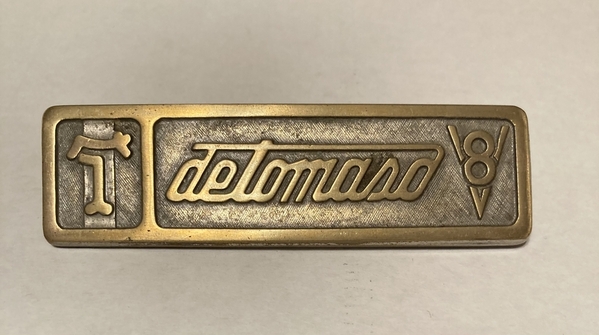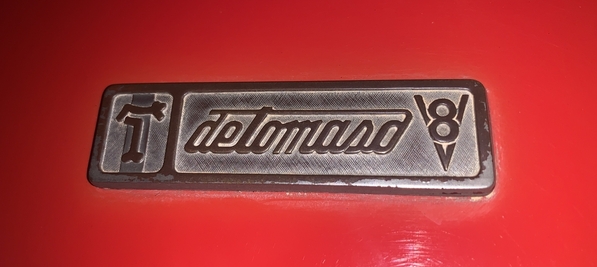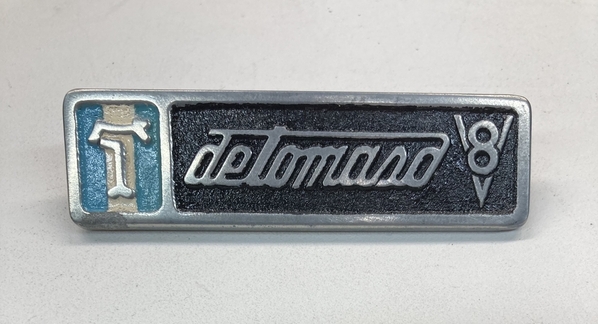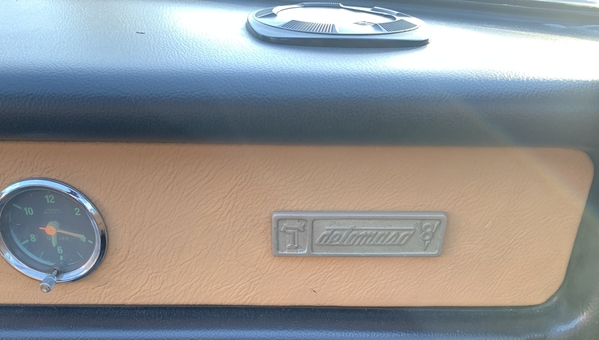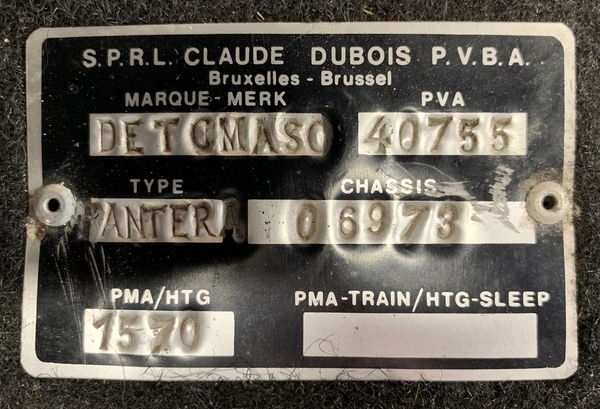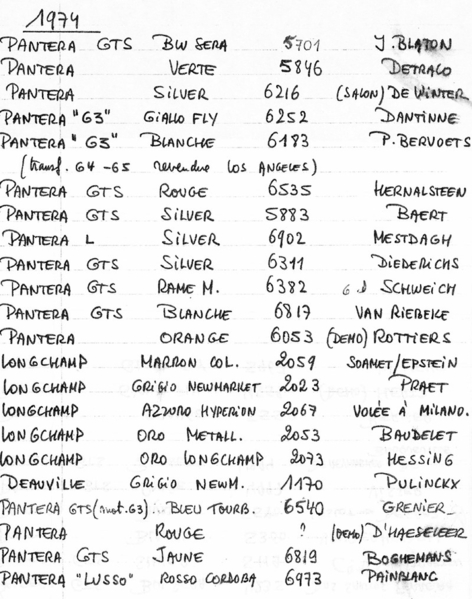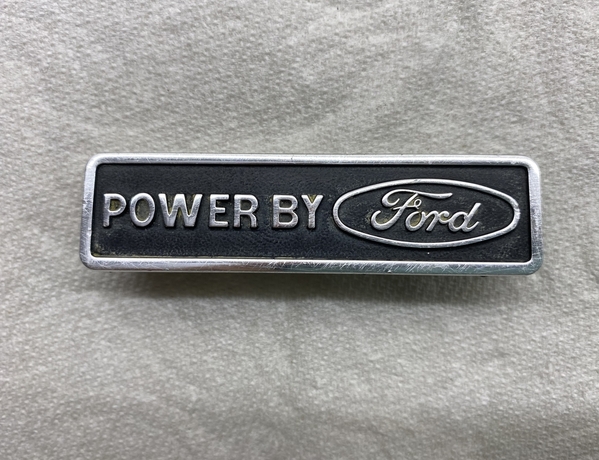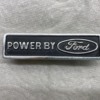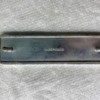Did all U.S. spec Panteras come with the "Power By Ford" emblem on the rear trunk lid?
Replies sorted oldest to newest
No.
The early cars had this emblem.
When Ford got their panties in a twist and bought out De Tomaso they wanted to strike all De Tomaso references, so they designed the power by Ford emblem.
I think the photo above is an OEM emblem that has lost most of its chrome and is showing the brass base metal.
Larry
Attachments
The nearly 50 year old emblem with missing paint and patina on my 74 Euro Pantera does not honor Ford as well:
Attachments
@stevebuchanan posted:
I have this emblem in my collection, but I always thought the colors were added later by an owner. They appear to be painted enamel.
Steve, when you say “missing paint”, do you mean they originally looked like this?
Larry
Attachments
Larry,
I think my emblem has been on the car for 49 years and is simply weathered. The black trim around the edge that was probably applied by the factory is slowly is coming off. The red paint on the deck lid is from the factory. You can see plenty of swirl marks in it.
Attachments
Not following - my 71 s/n 1744 has Powered by Ford on it and it was never replaced.
I just checked the orange parts book and they make no reference to the De Tomaso emblem. Which is not surprising because they had essentially divorced themselves from De Tomaso as I mentioned earlier.
There are definitely two emblems, but as to when the emblem was changed is destined to remain a mystery.
Larry
I think I read somewhere that Ford was unhappy that they were not getting any recognition on the car, so they made Alejandro install the "Power By Ford" emblem. Based on what Panterapatt contributed about s/n 1744, the Ford emblem may have been installed on vehicles even before Ford took over. Alejandro may have been using his emblem on all the European cars all along. It would be interesting to know if any of the early U.S. cars had Alejandro's emblem before they made hin change over, as Larry suggests, or if there was no emblem at all as seen in some of the early advertisements. The fact that the holes are located behind the brace make it difficult to prove the latter, and explain why they are mounted with push-ins, and not with studs and nuts.
There is a "Power By Ford" emblem on Ebay now here : Ford De Tomaso Pantera Deck Lid Powerd by Ford Emblem Nameplate_Milano_GENUINE | eBay which has "Milano Maggi" cast into the back. Obviously cast in Italy. Comments?
I am not following. Ford bought an 80% controlling stake in DeTomaso from Rowan Industries and Alesandro himself in 1970 (at least that is what all the historians have said). Panteras were not produced until 1971, all of which was under Ford's control from day one. Ford sold back their interest in 1974. I looked at the ProvaMO registry and the 4th earliest car there (s/n 1388) has POWERED by Ford emblem on it. So I would conclude they ALL had it and those with something else were put on after by some owner, just like many of the little DeTomaso badges that seem to show up on some cars.
For those unaware and sadly, Amory Haskell and his brother in law, John Corson died in a plane crash in March of 1970 - before the Pantera every made it into production. Amory and Carson ran Rowan Industries. Amory's sister was Isabella Detomaso and the connection to how DeTomaso got his money to fund the business. I guess it was good to be an heir to the DuPont fortune.
Incidentally, on the Hall Pantera site, the POWERED by Ford emblem says: "This came stock on all Panteras from 1971 to 1974". Gary wrote this and I believe Gary new his stuff on the topic of Panteras. The DeTomaso V8 badge says "this REPLACES the POWERED by Ford badge".
🤷♂️🤷♂️
The mystery deepens. I think I will throw this onto the email list and see what feedback I can get.
Larry
No mystery as to when Ford bought Rowan out nor when they started to build Panteras
Steve's is a Euro car which may explain his De Tomaso emblem. The fact that it is a '74, the year of the split may also factor in.
totally agreed
Mike Drew is of the opinion the De Tomaso V8 emblem was just on non-Ford cars.
This is one of those questions that the literature will not confirm one way or the other. Best confirmation will be coming from original owners. All other cars have 50 years of unknown history and who knows what a previous owner may have installed.
Larry
So do you think it would be on all the Euro cars and the '74 cars after the split?
... aka "likely scenarios," pending further confirmation from original owners, if there are any!
We are talking about deTomaso Panteras, right? And trying to figure out what is factory correct, right?
😂😂😂
my guess, your guess, anybody’s guess is as good as anyone else’s.
Larry
Attachments
> On 01/30/2023 10:33 AM The De Tomaso Forums <alerts@crowdstack.com> wrote:
>
>
>
>
>
A dashboard-mounted Veglia clock was definitely part of the 150 USA Panteras that contain GT in their VIN.
as far as European-sold GT models, the buyer could pretty much specify whatever they wanted on their individual build. I imagine the clock was installed on some European cars as well.
Larry
Larry,
What years were they?
This is likely how Claude Dubois ordered the car, along with the tan leather interior. Claude was the distributor for DeTomaso cars in Brussels. Below is the list of cars he sold in 1974. My car is last one on the list.
Attachments
The USA GT cars were sold in 1974. The 40 GT cars that were sold in California were sold as 1973 models due to emission issues.
Larry
Steve,
Very interesting list. Thank you for sharing.
Why do the serial #s range from 2023 to 6973? Perhaps he was selling used or leftovers in 1974? I have 2036 which was assembled in July '71 as a '72 model.
Was yours a GT model?
I noticed now that the eary #s were Longchamps.
John,
Thank you for weighing in. Exactly the kind of history documentation I was hoping would be available on this site.
On the list Claude called my car a "Lusso" (same as L). It is not a GTS although it has some of the same features as a GTS. Mine came out of the factory with small chrome bumpers.
Again, very interesting. Shows that Alejandro didn't necessarily burden his European deliveries with the U.S. mandated features. Larry is probably correct in that the Europeans could have them manufactured any way they wanted. "Semi-custom" so to speak. I wonder if any of the European model engines deviated from the open chamber low compression U.S. models.


